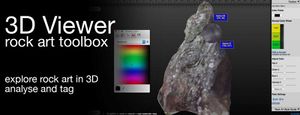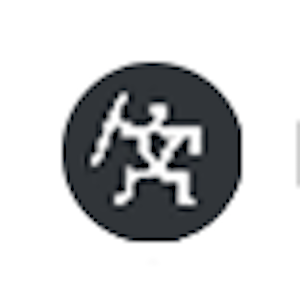Difference between revisions of "The Global Rock Art Database"
| Line 34: | Line 34: | ||
[[File:Rockartdatabase_3d_viewer_x3dom.jpg|thumb|Interactive 2D & 3D Model Viewer ([http://www.rockartdatabase.com/v2/wp-content/themes/v2/plugin_x3dom_images/index.html?img=http://www.rockartdatabase.com/v2/wp-content/uploads/admin/cpt-00-03/un15051822022/Ubirr_rock_art.jpg&w=8.37&h=5.73 test page])]] | [[File:Rockartdatabase_3d_viewer_x3dom.jpg|thumb|Interactive 2D & 3D Model Viewer ([http://www.rockartdatabase.com/v2/wp-content/themes/v2/plugin_x3dom_images/index.html?img=http://www.rockartdatabase.com/v2/wp-content/uploads/admin/cpt-00-03/un15051822022/Ubirr_rock_art.jpg&w=8.37&h=5.73 test page])]] | ||
| − | The Rock Art Database is a non-for profit online project that was founded by [Robert Haubt] with the support from [[Wikipedia:Paul Tacon|Paul Taçon]] at the Place Evolution and Rock Art Heritage Unit (PERAHU), Griffith University in Australia. It seeks to improve theory and practice in the digital curation of rock art data through building a centralized global heritage community network. Through the use of new technologies the database offers new ways to look at heritage data and explores the potential in digital curation. | + | The Rock Art Database is a non-for profit online project that was founded by [[Robert Haubt]] with the support from [[Wikipedia:Paul Tacon|Paul Taçon]] at the Place Evolution and Rock Art Heritage Unit (PERAHU), Griffith University in Australia. It seeks to improve theory and practice in the digital curation of rock art data through building a centralized global heritage community network. Through the use of new technologies the database offers new ways to look at heritage data and explores the potential in digital curation. |
== Aims == | == Aims == | ||
Revision as of 11:08, 30 August 2017
The Global Rock Art Database |
||
|---|---|---|
Original Author: |
Robert Haubt |
|
Developer(s): |
Robert Haubt |
|
Released: |
2012 |
|
Discontinued: |
||
Latest Version: |
v.2 |
|
Latest Release Date: |
2016 |
|
Latest Preview Version: |
||
Latest Preview Date: |
||
Status: |
active |
|
Programming Language: |
PHP, MySQL, javascript, HTML5 |
|
Operating System: |
Microsoft Windows, MacOS |
|
Platform: |
Desktop Computer, Android, iOS |
|
Size: |
2000MB |
|
Available in: |
1 languages |
|
Type: |
GIS |
|
License: |
Creative Commons |
|
Alexa: |
||
Website: |
||
Repository: |
GitHub |
|
Supported File Formats: |
JPEG, GIF, X3D |
|
----------Applied Fields---------- |
||
Used by Discipline: |
rock art |
|
Used by Sub-Discipline: |
Cultural Heritage Management |
|
Noteable Works: |
||
Noteable Ideas: |
||
Usefulness for Methodologies: |
Crowdsourcing |
|
Influenced by: |
{{{influenced}}}
|
|

The Rock Art Database is a non-for profit online project that was founded by Robert Haubt with the support from Paul Taçon at the Place Evolution and Rock Art Heritage Unit (PERAHU), Griffith University in Australia. It seeks to improve theory and practice in the digital curation of rock art data through building a centralized global heritage community network. Through the use of new technologies the database offers new ways to look at heritage data and explores the potential in digital curation.
Aims
- Build a global rock art heritage community
- Improve sharing and accessibility of rock art data
- Assist in the standardization of rock art heritage data models
- Find new ways to look at rock art data through the use of new technologies
History and Background
The Global Rock Art Database, Overview Tutorial
This project examines the curation, presentation and promotion of rock art heritage. It addresses the construction of a centralized global rock art database and explores new technologies available for looking at rock art. In 2011, Prof. Taçon Chair in Rock Art Research and Director of PERAHU (Place, Evolution and Rock Art Heritage Unit) at Griffith University called for a national rock art database raising awareness of the importance of preserving rock art as part of Australia’s valuable Indigenous heritage. Australia alone features over 100,000 rock art sites, important heritage places for Indigenous and non-Indigenous peoples and a testament to over 10,000 years of human activity, including interactions with other peoples and the environment. Many of these sites have not been documented or recorded and are threatened by natural and cultural agents. It is becoming increasingly important to develop conservation models for the protection and preservation of sites. Indigenous cultural heritage in particular is difficult to manage on a local government level due to complex human / time / environment relationships and the importance of intangible cultural heritage (Department of the Environment, 2011). Currently no centralised database system exists to curate, present and promote rock art. This project aims to fill this gap by offering the latest in digital archiving technologies from community and communication tools to GIS and Data Visualization.
References
- Haubt, R. (2015). The Rock Art Database: Developing A Rock Art Reference Model Using The CIDOC CRM And Australian Heritage Examples. ISPRS Annals of the Photogrammetry, Remote Sensing and Spatial Information Sciences, Volume II-5/W3, 2015 25th International CIPA Symposium 2015, 31 August – 04 September 2015, Taipei, Taiwan.
- Haubt, R. (2013). Building a Centralised Australian Rock Art Archive. SR7 Recording Applications. Int. Arch. Photogramm. Remote Sens. Spatial Inf. Sci., XL-5/W2, 319-324, doi:10.5194/isprsarchives-XL-5-W2-319-2013, 2013. XXIV International CIPA Symposium, 2-6 September 2013. Strasbourg. France.
- Haubt, R. (2015). Centralizing and Streamlining Heritage Data using the CIDOC Reference Model. Society for American Archaeology (SAA) Conference 2015. San Francisco, USA.
- Haubt, R. (2014). Building Online Communities in Cultural Heritage: The Rock Art Database (RADB). Postgraduate Symposium 2014, Griffith University. Brisbane, Australia.
- Haubt, R. (2014). The Rock Art Database (RADB): A Global Information System and Data Repository. WIP Conference 2014, University of Queensland. Brisbane, Australia.
- Haubt, R.A. (2014). Virtual Environment Archives, A Case Study of Cultural Preservation within Australian Rock Art Archives, Emerging Scholars Day, Griffith University, Southport, QLD, Australia.
- Haubt, R.A. (2014). (Guest Lecture) Rock Art in the 21st Century: The State of Australian Heritage Archives, Rock Art in the 21st Century, Course Convener Prof. P. Taçon, Griffith University, Southport, QLD, Australia.
- Haubt, R. (2013). An Open Source Approach to Centralize Rock Art Data in Australia. Scale and Granularity in Archaeological Data Management. Australian Archaeological Association (AAA) Conference, 2-6 December, (2013). Coffs Harbor, NSW. Australia.
- Haubt, R.A. (2013). Heritage Archives: Digitizing Rock Art Data in Australia, Combined Research Day, Griffith University, South Bank, QLD, Australia.
- Haubt, R.A. (2013). Virtual Environment Archives, A Case Study of Socio-Technological Antilogies in Cultural Preservation within Australian Rock Art Archives, Confirmation Paper Presentation, Griffith University, Southport, QLD, Australia.

